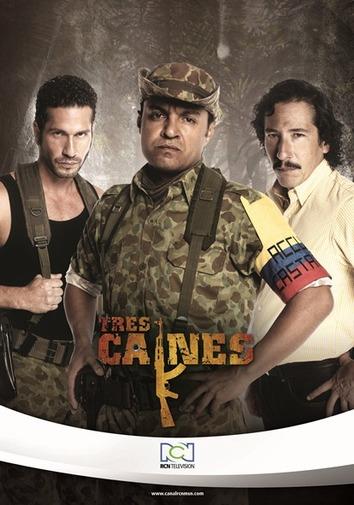
Poster for the Colombian telenovela Tres Caínes published on the RCN TELEVISIÓN website. The poster shows the three main characters of the series. From right to left, Fidel Castaño (played by Gregorio Pernia), Carlos Castaño (Julián Román) and Vicente Castaño (Elkin Díaz).
| Name of the telenovela: | Tres Caínes |
| Country: | Colombia |
| Original language: | Spanish |
| Television channel: | RCN Televisión |
| First broadcast: | March 4 to June 18, 2013 |
| Time of first broadcast: | Monday to Friday, 9:30 p.m. until April 12, 2013, then at 10:00 p.m. |
| Number of episodes: |
80 |
| Original idea: | Gustavo Bolívar |
| Script: | Gustavo Bolívar, Yesmer Uribe |
| Directos: |
Mauricio Cruz, Carlos Gaviria |
| Executive Producer: | Hugo León Ferrer |
| Producer: | Madeleine Contreras |
| Production company: | RTI |
Tres Caínes
Tres Caínes tells the story of the brothers Carlos, Fidel and Vicente Castaño Gil, recounting through fictional situations their activities as paramilitaries from the 1980s to the early 2000s in Colombia. The Castaño Gil brothers existed in real life and their paramilitary organization fought against guerrilla groups and was responsible for a series of crimes committed against civil society in the context of the Colombian armed conflict. An announcement preceding the presentation of each episode informs viewers that the telenovela is based on testimonies given in the proceedings carried out in the framework of the Justice and Peace Law initiated in 2005.
This telenovela is one of GUMELAB's case studies, because for the first time it dealt with the issue of paramilitarism in the Colombian armed conflict in a melodramatic key. In addition, it was broadcast in Colombia while the peace process between the Colombian government and FARC guerrillas in Havana, Cuba, was underway. Victims of paramilitarism in Colombia protested the representation of them in the telenovela, and a group of citizens organized a protest campaign on social networks against it. Currently, some of its protagonists and scriptwriters have become politicians and political activists in Colombia.
Sources and references
Castaneda, Érika (2015): "The telemory. Reception study of the series Tres Caines." (“La telememoria. Estudio de recepción de la serie Tres Caínes”). En Pereira, José (Ed.): Televisión y construcción de lo público. Bogotá: Editorial PUJ, 138.
Contreras Saiz, Mónika (2017): “Drug trafficking and soap operas in Colombia: between narco-novels and "telenovelas de la memoria". (“Narcotráfico y telenovelas en Colombia: entre narconovelas y “telenovelas de la memoria”). Hispanorama, N. 157, p.26 – 31.
Ospina Raigosa, Luis Eduardo (2017): Social response of the victims' movement against the RCN channel. Analysis of the video sit-in No more Tres Caines. (Respuesta social del movimiento de víctimas contra el canal RCN. Análisis del vídeo plantón No más Tres Caínes). En: Neyla Graciela Pardo Abril (Ed.): Semiótica.
Comunicación, cultura y cognición. Bogotá: Universidad Nacional de Colombia (Colección Dirección de investigación y extensión, Sede Bogotá), p. 271–290.
Rodríguez Pinilla, Liliana Marlén (2018): The Colombian State and crimes against humanity through the prism of the television screen. A study of the series Tres Caínes. (El Estado colombiano y los crímenes de lesa humanidad en el prisma de la pantalla televisiva. Un estudio acerca de la serie Tres Caínes). Master's Thesis in Sociology. National University of Colombia, Bogotá.
